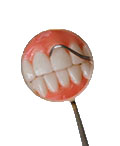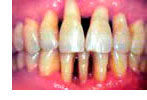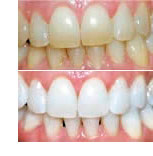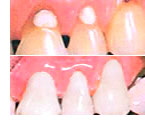FAQ
We know you may have questions (faq). Below are some of the most common things we’re asked about at Dental Palermo as well as some helpful tips. If you still have questions, please call us or send us an email and we will be happy to answer them.
Dental Cavities
The earliest sign of a new carious lesion is the appearance of a chalky white spot on the surface of the tooth, indicating an area of demineralization of enamel. This is referred to as an incipient carious lesion or “microcavity”. As the lesion continues to demineralize, it can turn brown but will eventually turn into a cavity. Before the cavity forms the process is reversible, but once a cavity forms the lost tooth structure cannot be regenerated. A lesion that appears brown and shiny suggests dental caries was once present but the demineralization process has stopped, leaving a stain. A brown spot that is dull in appearance is probably a sign of active caries.

As enamel and dentin are destroyed, the cavity becomes more noticeable. The affected areas of the tooth change color and become soft to the touch. Once the decay passes through enamel, the dentinal tubules, which have passages to the nerve of the tooth, become exposed, resulting in a toothache.
Periodontics
What is it?

Periodontics is the specialty of dentistry that studies supporting structures of teeth, diseases, and conditions that affect them. The supporting tissues are known as the periodontium, which includes the gingiva (gums), alveolar bone, cementum, and the periodontal ligament.
Gingivitis

A very common condition in which the gums are inflamed and therefore the hallmark of this disease is the bleeding of the same. Actually it is a problem that does not cause discomfort or pain, but if you pass by without giving the necessary attention, progresses to periodontitis. The primary cause of gingivitis is poor oral hygiene, which leads to accumulation of plaque formation and the resulting plaque. There are other factors, such as hormonal changes.
Early Periodontitis

Gingivitis usually results in a timely unattended. In periodontitis gum bleeding is higher and there is a generous accumulation of dental plaque and tartar. As can be seen hallmark areas where the gum has been retracted and a portion of the tooth root is uncovered, in addition to the loss of alveolar bone that supports the teeth, because it is a degenerative inflammatory process.
Advanced Periodontitis

If early periodontitis is not treated and controlled, it is ongoing and results in what is known as advanced periodontitis. This is a really serious disease resulting spontaneous eviction teeth as a result of excessive loss of alveolar bone that supports them. There is a great accumulation of dental plaque and tartar, as well as discharge of pus from the spread of infection.
Cosmetic procedures
Composite resin

A composite filling is a tooth-colored plastic and glass mixture used to restore decayed teeth. Composites are also used for cosmetic improvements of the smile by changing the color of the teeth or reshaping disfigured teeth. Composite does not require the retention cavity carved to contain (as in the case of the amalgam), this makes it the material of choice for conservative restoration.
Aesthetic Veneers

A veneer is a thin layer of material placed over a tooth, either to improve the aesthetics of a tooth or to protect a damage to a tooth’s surface. There are two main types of material used to fabricate a veneer: composite and dental porcelain. A composite veneer may be directly placed (built-up in the mouth), or indirectly fabricated by a dental technician in a dental laboratory, and later bonded to the tooth, typically using a resin cement. In contrast, a porcelain veneer may only be indirectly fabricated.
Teeth Whitening

Tooth whitening lightens teeth and helps to remove stains and discoloration. Whitening is among the most popular cosmetic dental procedures because it can greatly improve how your teeth look. Most dentists perform tooth whitening. Whitening is not a one-time procedure. It will need to be repeated from time to time if you want to maintain the brighter color. The outer layer of a tooth is called the enamel. The color of natural teeth is created by the reflection and scattering of light off the enamel, combined with the color of the dentin under it. Your genes affect the thickness and smoothness of the enamel. Thinner enamel allows more of the color of the dentin to show through. Having smoother or rougher enamel also affects the reflection of light and therefore the color. There are two main types of whitening procedures. Non-vital whitening is done on a tooth that has had root-canal treatment and no longer has a live nerve. Vital whitening is performed on teeth that have live nerves.
Compomers

Dental compomers are materials which are used in dentistry as restorative material. They were introduced in the early 1990s as a hybrid of two other dental materials: dental composites and glass ionomer cement. They are used for restorations in low stress bearing areas.
